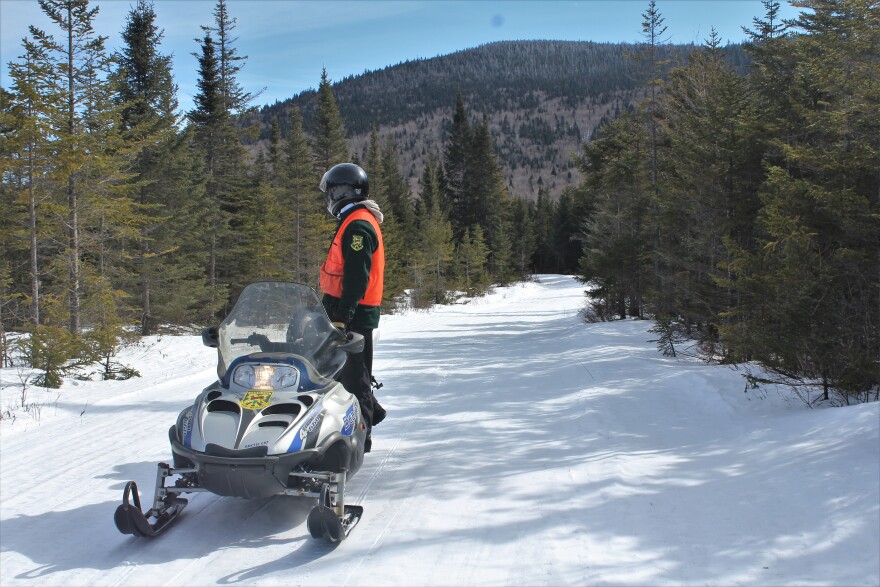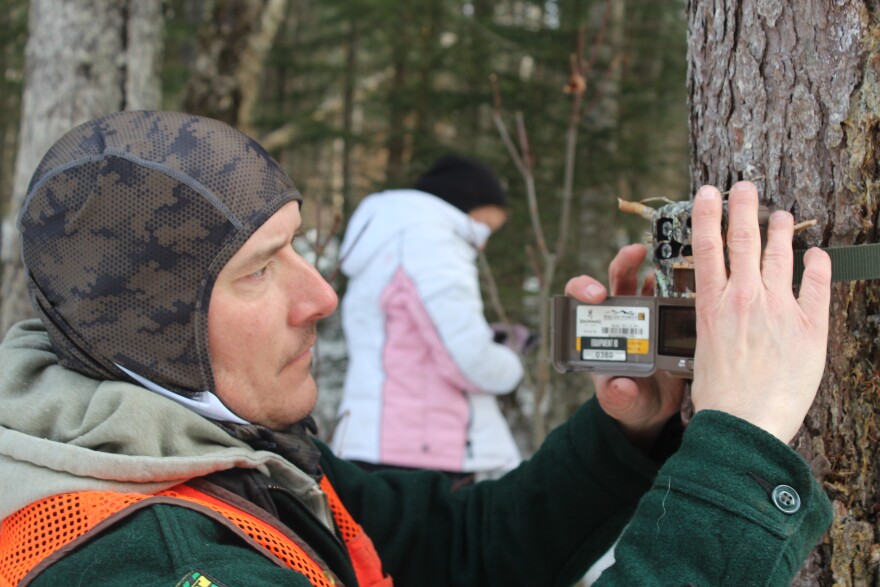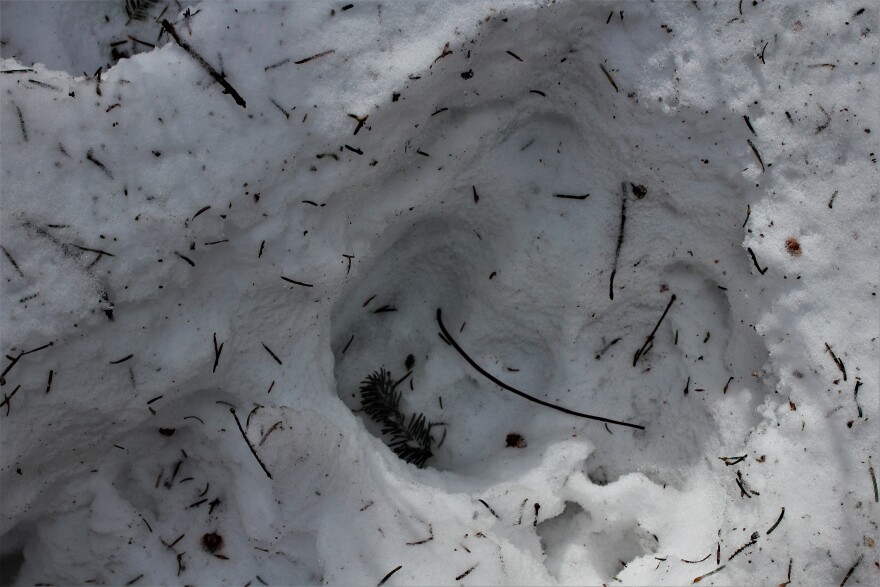As New England winters warm, moose are getting overwhelmed by winter ticks. Some scientists say hunting could help.

When moose rub against trees in attempt to remove winter ticks, they can scrape off much of their dark brown hair, exposing pale undercoat and grey skin, like this female. These animals are nicknamed “ghost moose.” (Daniel Bergeron for NHFG)
On a cold, sunny day in a remote part of Vermont’s rugged Northeast Kingdom, Nick Fortin — Vermont Fish and Wildlife’s lead moose biologist — holds onto his snowmobile helmet as he gestures to some young trees. The new growth from logging at this spot, in addition to its remote and mountainous setting, makes for prime moose habitat.
“It’s sort of a high elevation basin between two mountains,” he says. “And it’s mostly dominated by spruce and fir.”
After a long snowmobile ride on a labyrinth of logging roads, Fortin and his colleagues are here to set up game cameras. The goal is to build a model that will help biologists track the health of New England’s moose population in real time.
Listen to the audio version of this story on VPR.org.
In recent decades, the relationship between moose and one of their parasites, the winter tick, has changed. It’s an old relationship — winter ticks have been found on moose in Vermont dating back to at least the 1980s.
But in Vermont and elsewhere in northern New England, shorter winters with less snow mean the ticks now pose a bigger threat to moose than they did in the past.
Wildlife managers in Vermont and Maine hope hunting more moose might help.
“This year is a perfect example,” Fortin says. “We’re out here at the end of February and there’s maybe a foot of snow, and we’re at 2,500 feet of elevation. I mean, we should have 4 to 5 feet of snow on the ground right now, and there’s a little over a foot.”

A member of Vermont Fish and Wildlife’s moose crew looks at young vegetation in a remote, high basin in East Haven. Logging at this spot in recent decades created a lower, younger forest, with ample food for moose within reach of their heads. (Abagael Giles/VPR)
The problem is swarms of winter tick nymphs seek out a host just before first snow.
“We often call them tick bombs,” Fortin said.
They can’t survive long in the snow without a host. When snow comes late, they have more time to find one.
Unlike, for example, black legged ticks, which seek out multiple hosts over the course of their life cycle, winter ticks stay with a single host through the winter, feeding multiple times.
Unlike white-tailed deer, moose are poor groomers. As a result, a single animal can carry as many as 90,000 ticks through the season.
In the spring, the ticks drop off to reproduce. Their odds of survival go up if they land on bare ground rather than on snow, and they don’t travel far to reproduce. So the more moose in an area, the more ticks.
Since moose like to eat the new growth in areas with recent logging like this part of the Northeast Kingdom, it means they often have denser than normal moose populations.
“And yeah, we got used to that, but it’s not probably something that’s sustainable in the face of winter ticks and climate change,” Fortin says.
Right now, only about half of moose calves survive their first winter in this basin because they get overwhelmed by ticks. Biologists say reducing the density of moose here by about half would help.
But Fortin says: “That’s a tough sell to a lot of people.”
“Is there any way to prove to Vermonters in three years, four years, five years that the moose herd is now healthier, and that’s due to the moose hunt?” — Brenna Galdenzi, Protect Our Wildlife
Brenna Galdenzi is with the advocacy group Protect Our Wildlife, Vermont. She’s concerned about Vermont’s moose population, and the idea of hunting them, given the other threats to their success here.
“How will we know that this experiment worked?” she asked. “Is there any way to prove to Vermonters in three years, four years, five years that the moose herd is now healthier, and that’s due to the moose hunt?”
Vermont Fish and Wildlife manages the state’s wildlife for both hunting and conservation.
Galdenzi says the agency has a bias towards hunters over other recreation groups. She worries that’s playing a role in their plans for the moose.
More than 75% of the funding for the moose monitoring research came from the U.S. Fish and Wildlife Service and the U.S. Geological Survey, but a trophy hunting group — Safari Club International — donated to an earlier part of the study.
One state away, Maine is in the second year of a similar experiment.
“I think we fully recognize as managers and biologists that the idea, the concept of hunting moose to improve the health and circumstances is a completely counterintuitive thing,” said Lee Kantar, Maine’s moose biologist.
Maine now sees about two weeks less winter than it did a century ago, and Kantar says those two weeks are the difference between life and death for calves.
“What we’re living with is the winter-tick-moose-climate dynamic,” he said. “And this is our way of trying to do something now, and not ponder it for another five years.”

Wildlife specialist Tony Smith sets up a game camera on a tree in Victory. Across from the camera, the crew set up a snow stake with a turkey feather at the top, doused in skunk scent. The goal is to attract curious moose, so wildlife biologists can count them, see their physical health and what types of habitat they favor within this block of the Northeast Kingdom. The cameras will generate hundreds of thousands of images, and artificial intelligence will help the scientists sift through them to identify moose. (Abagael Giles/VPR)
Moose are an iconic species for northern New England states — especially Maine. But there’s a longer history here too.
Chuck Loring is director of natural resources for the Penobscot Nation. Tribal land sits adjacent to some of the zones where Maine plans to ramp up moose permits this season.
In Vermont, members of state recognized Abenaki tribes can apply for free hunting and fishing licenses, but they have to compete with people who are not Indigenous in the annual lottery for moose permits.
In contrast, each Penobscot household has the right to hunt one moose every year for subsistence. It’s been that way for more than 12,000 years, or as Chuck Loring says, “since ‘time immemorial.’”
One moose can feed a family for a year — grandparents, kids, adults and even neighbors.
He says the changing climate and its impact on moose, as well as other species, is a big concern.
“It’s a big problem that we’re looking at right now,” he said. “As far as worrying about what the climate change that’s happening right before our eyes… is going to do to the composition of our forests and what it could do to potentially shift species that are occupying this soil right now.”
Loring says there are things outside the nation’s boundaries that will play a role in the fate of moose, and the world without them is not something he likes to dwell on.
Someday soon, there might be a way to manage the ticks themselves — rather than the moose.

Vermont Fish and Wildlife estimates, based on past surveys, that the density of moose in this part of the Northeast Kingdom is about two animals per square mile. They say a density of one animal per square mile would be better for managing winter ticks. (Abagael Giles/VPR)
Cheryl Frank Sullivan is an entomologist at the University of Vermont. She’s been looking into a different approach: kill the ticks using pesticides made of fungi found naturally in New England soils.
Spoiler: more research is needed.
But in the meantime, Frank Sullivan says reducing the density of moose hosts on the landscape — moose social distancing, if you will — may just be the best option available.
“It’s weather conditions, host density and the overlap of that seasonal habitat use by moose that are really the main factors that drive the winter tick abundance on the landscape and subsequently the epizootic risk for moose,” Frank Sullivan said.
After several years with very little or no hunting, Vermont issued 100 moose permits last year. Vermont Fish and Wildlife is recommending the same this year, with all of the permits being for Essex County, where the moose are most dense.
The state is collecting public feedback on that proposal through May 14.
Find more about how to weigh in, here.
Have questions, comments or tips? Send VPR a message or get in touch with reporter Abagael Giles @AbagaelGiles.
